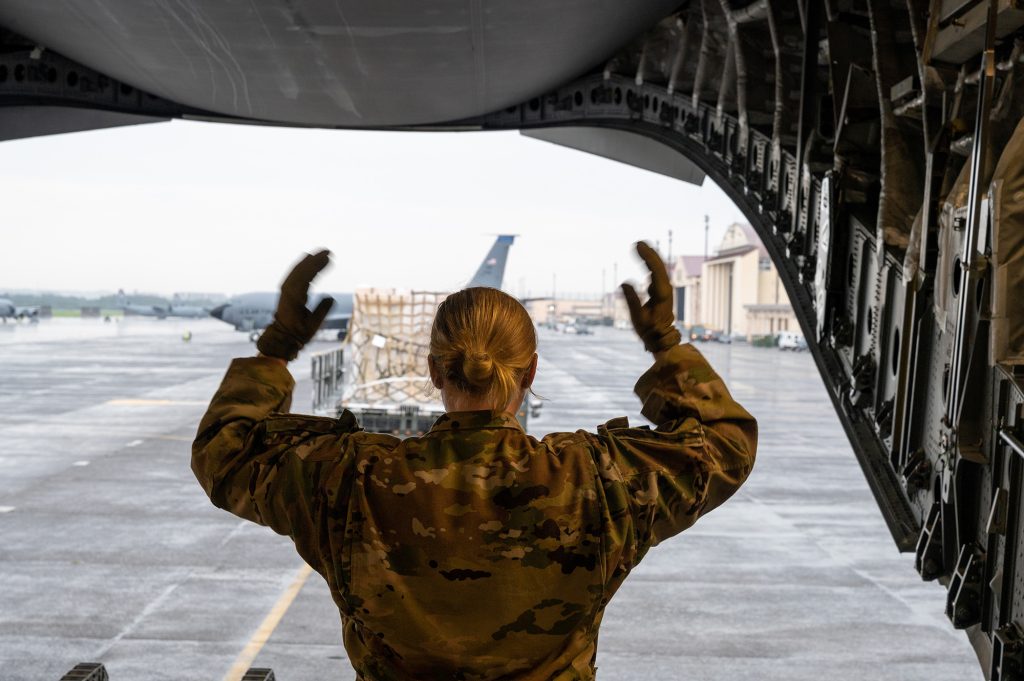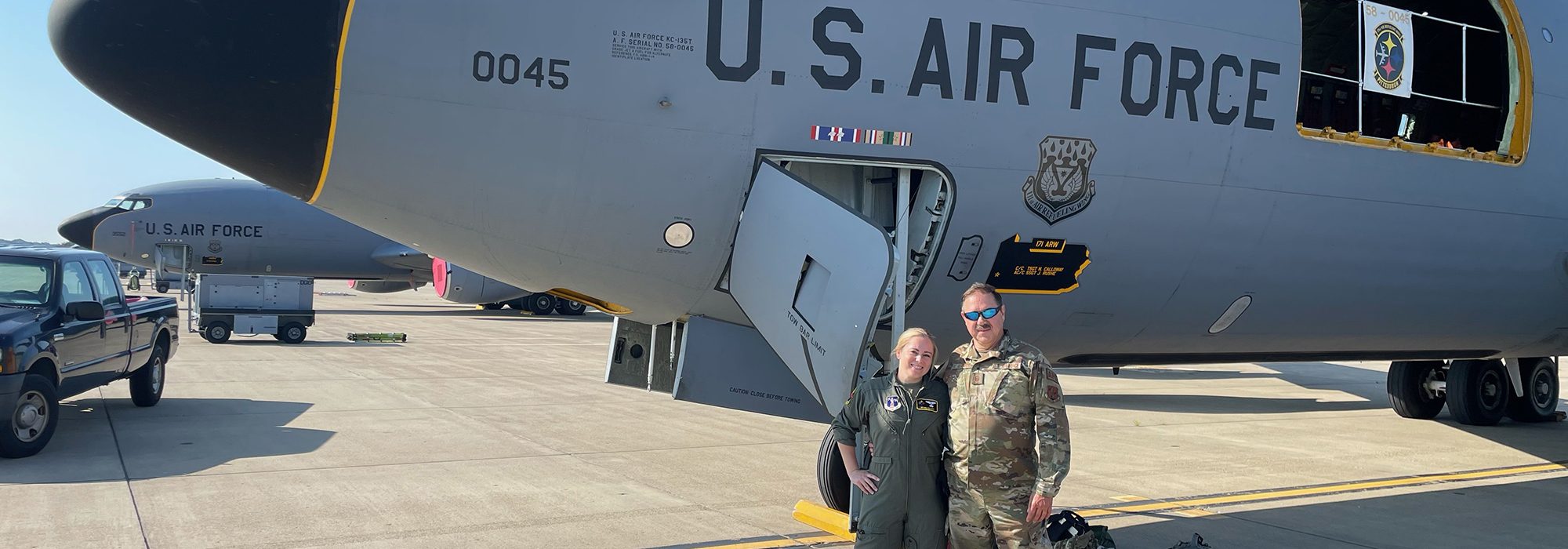38-Year KC-135 Crew Chief Marshals His Daughter’s First Takeoff
By David Roza
Master Sgt. Kevin Clancy has launched KC-135 tail number 58-0045 countless times over his career as a crew chief, but one flight July 6 was different from the rest. This time, his own daughter was taking his pride and joy down the runway.
“I went over the checklist again and again in my head that day,” Clancy told Air & Space Forces Magazine. “You launch hundreds of jets over the years, but this one had my kid on it.”
1st Lt. Megan Hirlehey was 0045’s co-pilot that day on her first mission assigned to the Pennsylvania Air National Guard’s 171st Air Refueling Wing. Hirlehey had practically grown up on the wing’s base outside Pittsburgh, where Clancy has worked since the late 1980s.
“I wanted to do this ever since I was a kid,” she said.
Aerial refueling has long been a family affair for the two Airmen. As first reported in a recent press release, Clancy stayed on base for five straight days during the high-alert period immediately after Sept. 11, 2001. At one point his wife and two daughters stopped by to drop off a clean set of clothes, and during the visit one of the KC-135 pilots, Brian Krawchyk, took the kids to a refrigerator on base.
“He said, ‘Close your eyes,’ and then he opened the door and it was full of ice cream,” Clancy recalled. “The family joke is that that’s what made Megan decide to join the Guard.”
For her part, Hirlehey remembers seeing flight-suited aviators walking around the base and wanting to join their ranks, but it wasn’t the easiest journey. She enlisted with the 171st shortly before graduating high school in 2008, serving in the base’s education and training office and as an aerial port specialist at the base’s air terminal. Her goal was to commission and become a pilot, but there was a problem: at 5-foot-2, she did not meet the Air Force’s height requirement, and she was unable to get a waiver.
Her luck turned a few years later when the Air Force changed its height requirements to expand the pool of eligible pilot candidates. She finally received a waiver and was approved in 2019, but there was another problem: the COVID-19 pandemic, which made an already-long process that much longer.
Hirlehey’s patience paid off: she commissioned in 2020, made it through the Air Force’s pilot training pipeline, and reported back to the 171st earlier this year.
“It’s just very surreal to be back here,” she said. “I watched the pilots walk around here for 15 years wanting to be one of them.”
As the day of Hirlehey’s first flight with the wing drew near, Clancy requested to work in the aircraft hangar that day to make sure he could see his daughter take off. He got more than that: the mission planners made sure Hirlehey’s first flight was on 58-0045, the jet Clancy had served on as dedicated crew chief for six years. At one point Clancy named the jet “Global Reach” and designed nose art of the jet refueling a B-52 bomber over the Western Hemisphere.
“I called it ‘Global Reach’ because that’s what tankers provide to the Air Force,” he said.
Over the course of countless hours keeping an aircraft ready to fly, many crew chiefs come to think of their jets as their own flesh and blood. On July 6, Clancy watched his daughter fly away with his baby, so to speak. The crew chief waved the aircraft out of the chocks and saluted on its way out. He stood on the pilot’s side, according to standard practice, so he could not directly see Hirlehey through the cockpit window, but he walked away “smiling ear to ear” nonetheless.
“With a jet that old there’s always a chance something might not work,” he said. “I was so thankful that she didn’t have to go to a spare.”
A few hours and an uneventful flight later, Hirlehey returned the KC-135 safe and sound, and Clancy turned the jet around so it was ready for the next mission. The flight marked a changing of the guard: as Hirlehey begins her own flying career, Clancy is set to retire in three months after 38 and a half years in uniform. The flight was “kind of the last thing I’m hanging around for,” he said.
The old hand was grateful to end things on such a high note.
“Not many crew chiefs get to retire with this honor,” he said.

3,700 Airmen No Longer Rate Special Duty Assignment Pay
By Greg Hadley
Flight engineers, loadmasters, and sensor operators are among the 3,700 Airmen who will stop receiving special duty assignment pay (SDAP) over the next year, Air & Space Forces Magazine has confirmed.
All told, 33 Air Force specialties will no longer qualify for SDAP starting in fiscal 2024. The payments range from $75 to $450 per month, and vary based on skill level, assignment location, and training.
The cuts will be gradual—communities being phased out will continue to receive half their prior amount through fiscal 2024, then lose it entirely in fiscal 2025.
Officials planned similar cuts a year ago, only to reverse course before the changes went into effect. Exactly who will or won’t be eligible has been withheld from public view. The Air Force offered no justification for withholding the actual list, which it has released in the past. The other military services also routinely publish details of who qualifies for the special pay, which is worth from $75 to $450 per month.
According to Air Force budget documents, the 3,708 Airmen who will no longer receive SDAP will suffer a net lost of $4.04 million, or about $90 per month on average. Most will actually lose $75 or $150 per month.
Last year, when the Air Force also planned SDAP cuts, the reductions would have been less far reaching, with 489 Airmen losing a total of $1.5 million, or an average of $255 per month. Air Force Secretary Frank Kendall canceled that plan amid an outcry over pay cuts at a time of high inflation.
According to the Air Force release, the board reviewing requests for SDAP this year were unaware of the budgeted funds for the program until after each request was considered.
The Space Force hosted its own SDAP board for the first time for fields that had moved into its jurisdiction. That board approved 14 job specialties, while cutting three, adding two, and “rolling” one into an existing approval. Space Force budget documents indicate funding and the number of Guardians included in the program is expected to stay flat in 2024. The Space Force followed the Air Force’s lead and withheld the list from public release, linking from a public press release to a private webpage. Department of the Air Force public affairs officials were unable to offer an explanation for withholding the details.
Special Duty Assignment Pay Changes
Jobs That No Longer Qualify
- President’s Emergency Ops Center
- Cryptologic Language Analyst
- Electronic Security Systems
- Aircraft Battle Damage Repair Exp Depot Mx
- Defense Threat Reduction Agency (DTRA)
- 361st Intelligence, Surveillance, and Reconnaissance Group (ISRG)
- Defense Couriers
- 31st Communication Squadron and 39th Communication Squadron NC3
- Army Support Weather Ops
- Flight Attendants
- 52nd Munitions Maintenance Group NC3
- Airborne Mission System Operators
- Flight Engineers
- Loadmasters
- Sensor Operators
- Special Mission Aviators
- Contracting
- RPA Cyber Technicians
- International Enlisted Engagements Managers
- RPA Ops – Weather Support
- Modular Airborne Fire Fighting System
- SuperHigh Frequency Operators
- Advanced Intelligence Instructors
- Ski Mission – Flight Eng and Loadmasters
- Airborne MSS – Host Nation Riders
- 55th Operations Group Management Operator
- 336th Training Squadron & 98th DRA Aircrew Flight Equipment
- Diagnostic Med Sonogram
- Honor Guard
- ANG RPA Cyber Ops
- Radar, Airfield, & Weather Systems
- Casualty Cell
- Military Working Dog Handlers
- Airmen who join these job communities after the start of fiscal 2024 on Oct. 1 will not qualify for the 50 percent SDAP rate offered to those being phased out of the program.
Jobs Where Pay Will Be Reduced
- Military Human Intelligence
- 724th Special Tactics Group Operations Support
- Subsurface Analyst
- Parachuting Instructor
- 33rd Cyberspace Operations Squadron Operating Location Alpha
- Mission Field Chief
- Special Ops Surgical Team
- Airmen in specialties getting their SDAP rates reduced will have a 90-day grace period after the start of the fiscal year before those cuts go into effect.
Jobs That Will Newly Qualify
- Material Management
- Bomber Airborne Maintenance Support
- United States Air Force Academy Enlisted Faculty Instructor
- Special Missions Support

